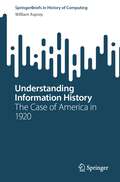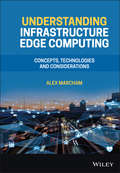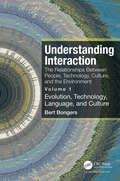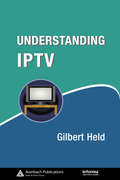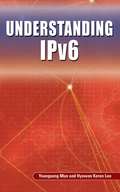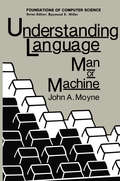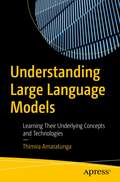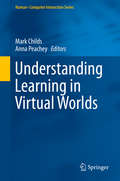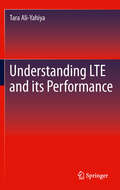- Table View
- List View
Understanding Information: An Introduction (Information Systems Series)
by Jonathan Liebenau James Backhouse...gives insight into the way in which information, and its creation out of data, are at the core of organizational life.' Peter Checkland, European Journal of Information Systems
Understanding Information: From the Big Bang to Big Data (Advanced Information and Knowledge Processing)
by Alfons Josef SchusterThe motivation of this edited book is to generate an understanding about information, related concepts and the roles they play in the modern, technology permeated world. In order to achieve our goal, we observe how information is understood in domains, such as cosmology, physics, biology, neuroscience, computer science, artificial intelligence, the Internet, big data, information society, or philosophy. Together, these observations form an integrated view so that readers can better understand this exciting building-block of modern-day society. On the surface, information is a relatively straightforward and intuitive concept. Underneath, however, information is a relatively versatile and mysterious entity. For instance, the way a physicist looks at information is not necessarily the same way as that of a biologist, a neuroscientist, a computer scientist, or a philosopher. Actually, when it comes to information, it is common that each field has its domain specific views, motivations, interpretations, definitions, methods, technologies, and challenges. With contributions by authors from a wide range of backgrounds, Understanding Information: From the Big Bang to Big Data will appeal to readers interested in the impact of ‘information’ on modern-day life from a variety of perspectives.
Understanding Information and Computation: From Einstein to Web Science
by Philip TetlowThe World Wide Web is truly astounding. It has changed the way we interact, learn and innovate. It is the largest sociotechnical system humankind has created and is advancing at a pace that leaves most in awe. It is an unavoidable fact that the future of the world is now inextricably linked to the future of the Web. Almost every day it appears to change, to get better and increase its hold on us. For all this we are starting to see underlying stability emerge. The way that Web sites rank in terms of popularity, for example, appears to follow laws with which we are familiar. What is fascinating is that these laws were first discovered, not in fields like computer science or information technology, but in what we regard as more fundamental disciplines like biology, physics and mathematics. Consequently the Web, although synthetic at its surface, seems to be quite 'natural' deeper down, and one of the driving aims of the new field of Web Science is to discover how far down such ’naturalness’ goes. If the Web is natural to its core, that raises some fundamental questions. It forces us, for example, to ask if the central properties of the Web might be more elemental than the truths we cling to from our understandings of the physical world. In essence, it demands that we question the very nature of information. Understanding Information and Computation is about such questions and one possible route to potentially mind-blowing answers.
Understanding Information and Computation: From Einstein to Web Science
by Philip TetlowThe World Wide Web is truly astounding. It has changed the way we interact, learn and innovate. It is the largest sociotechnical system humankind has created and is advancing at a pace that leaves most in awe. It is an unavoidable fact that the future of the world is now inextricably linked to the future of the Web. Almost every day it appears to change, to get better and increase its hold on us. For all this we are starting to see underlying stability emerge. The way that Web sites rank in terms of popularity, for example, appears to follow laws with which we are familiar. What is fascinating is that these laws were first discovered, not in fields like computer science or information technology, but in what we regard as more fundamental disciplines like biology, physics and mathematics. Consequently the Web, although synthetic at its surface, seems to be quite 'natural' deeper down, and one of the driving aims of the new field of Web Science is to discover how far down such ’naturalness’ goes. If the Web is natural to its core, that raises some fundamental questions. It forces us, for example, to ask if the central properties of the Web might be more elemental than the truths we cling to from our understandings of the physical world. In essence, it demands that we question the very nature of information. Understanding Information and Computation is about such questions and one possible route to potentially mind-blowing answers.
Understanding Information History: The Case of America in 1920 (SpringerBriefs in History of Computing)
by William AsprayMicrohistory is a technique that has been used effectively by writers of both fiction and nonfiction. It enables the author to cut through the complexities of large swaths of history by focusing on a particular time and place. Microhistories are particularly useful in historical study when a subfield has recently arisen and there are not yet enough monographic studies from which to draw general patterns. This microhistory focuses on a single year (1920) across the United States, with the goal of understanding the various roles of information in this society. It gives greater emphasis to the informational aspects of traditional historical topics such as farming, government bureaucracy, the Spanish flu pandemic, and Prohibition; and it gives greater attention to information-rich topics such as libraries and museums, schools and colleges, the financial services and office machinery industries, scientific research institutions, and management consultancies.
Understanding Information Retrieval Systems: Management, Types, and Standards
by Marcia J. BatesIn order to be effective for their users, information retrieval (IR) systems should be adapted to the specific needs of particular environments. The huge and growing array of types of information retrieval systems in use today is on display in Understanding Information Retrieval Systems: Management, Types, and Standards, which addresses over 20 typ
Understanding Information Retrieval Systems: Management, Types, and Standards
by Marcia J. BatesIn order to be effective for their users, information retrieval (IR) systems should be adapted to the specific needs of particular environments. The huge and growing array of types of information retrieval systems in use today is on display in Understanding Information Retrieval Systems: Management, Types, and Standards, which addresses over 20 typ
Understanding Information Transmission (IEEE Press Understanding Science & Technology Series #18)
by John B. Anderson Rolf JohnnessonUnderstanding Information Transmission introduces you to the entire field of information technology. In this consumer handbook and introductory student resource, seven chapters span the gamut of the field—the nature, storage, transmission, networking, and protection of information. In addition to the science and technology, this book brings the subject alive by presenting the amazing history of information technology, profiling incredible inventions and fascinating inventors, and their dramatic impact on society. Features include problem sets, key points, suggested reading, review appendices, and a full chapter on mathematical methods. Private and public funding of information technology continues to grow at staggering rates. Learn what’s behind this race to be the biggest, brightest, and fastest in the field with Understanding Information Transmission.
Understanding Infrastructure Edge Computing: Concepts, Technologies, and Considerations
by Alex MarchamA comprehensive review of the key emerging technologies that will directly impact areas of computer technology over the next five years Infrastructure edge computing is the model of data center and network infrastructure deployment which distributes a large number of physically small data centers around an area to deliver better performance and to enable new economical applications. It is vital for those operating at business or technical levels to be positioned to capitalize on the changes that will occur as a result of infrastructure edge computing. Understanding Infrastructure Edge Computing provides a thorough understanding of the growth of internet infrastructure from its inception to the emergence of infrastructure edge computing. Author Alex Marcham, an acknowledged leader in the field who coined the term 'infrastructure edge computing,' presents an accessible, accurate, and expansive view of the next generation of internet infrastructure. The book features illustrative examples of 5G mobile cellular networks, city-scale AI systems, self-driving cars, drones, industrial robots, and more—technologies that increase efficiency, save time and money, and improve safety. Covering state-of-the-art topics, this timely and authoritative book: Presents a clear and accurate survey of the key emerging technologies that will impact data centers, 5G networks, artificial intelligence and cyber-physical systems, and other areas of computer technology Explores how and why Internet infrastructure has evolved to where it stands today and where it needs to be in the near future Covers a wide range of topics including distributed application workload operation, infrastructure and application security, and related technologies such as multi-access edge computing (MEC) and fog computing Provides numerous use cases and examples of real-world applications which depend upon underlying edge infrastructure Written for Information technology practitioners, computer technology practitioners, and students, Understanding Infrastructure Edge Computing is essential reading for those looking to benefit from the coming changes in computer technology in the near future.
Understanding Infrastructure Edge Computing: Concepts, Technologies, and Considerations
by Alex MarchamA comprehensive review of the key emerging technologies that will directly impact areas of computer technology over the next five years Infrastructure edge computing is the model of data center and network infrastructure deployment which distributes a large number of physically small data centers around an area to deliver better performance and to enable new economical applications. It is vital for those operating at business or technical levels to be positioned to capitalize on the changes that will occur as a result of infrastructure edge computing. Understanding Infrastructure Edge Computing provides a thorough understanding of the growth of internet infrastructure from its inception to the emergence of infrastructure edge computing. Author Alex Marcham, an acknowledged leader in the field who coined the term infrastructure edge computing presents an accessible, accurate, and expansive view of the next generation of internet infrastructure. The book features illustrative examples of 5G mobile cellular networks, city-scale AI systems, self-driving cars, drones, industrial robots, and more—technologies that increase efficiency, save time and money, and improve safety. Covering state-of-the-art topics, this timely and authoritative book: Presents a clear and accurate survey of the key emerging technologies that will impact data centers, 5G networks, artificial intelligence and cyber-physical systems, and other areas of computer technology Explores how and why Internet infrastructure has evolved to where it stands today and where it needs to be in the near future Covers a wide range of topics including distributed application workload operation, infrastructure and application security, and related technologies such as multi-access edge computing (MEC) and fog computing Provides numerous use cases and examples of real-world applications which depend upon underlying edge infrastructure Written for Information technology practitioners, computer technology practitioners, and students, Understanding Infrastructure Edge Computing is essential reading for those looking to benefit from the coming changes in computer technology in the near future.
Understanding Initial Coin Offerings: A New Era of Decentralized Finance (Understanding series)
by Dmitri BoreikoDelving into the comprehensive evolution of Initial Coin Offerings (ICOs), this innovative book traces their origins and transition into modern forms such as Security Token Offerings, Initial Exchange Offerings, Initial DEX Offerings and Non-Fungible Tokens. It provides an in-depth analysis of the factors behind the appeal of ICOs, the complex ecosystem surrounding them, and the key developments within the blockchain and cryptocurrency space.Countering common misconceptions such as equating ICOs with fraud, Dmitri Boreiko emphasizes the need for robust regulation in the field. Chapters explore the economics of ICOs, offer practical research guidance and navigate the complexities of ICO regulation. The book concludes by highlighting emerging mechanisms in blockchain fundraising, focusing on the increased security, transparency, and flexibility of newer mechanisms.Concise and incisive, this is a timely read for economics students focusing on ICOs and blockchain applications, as well as fintech more broadly. Written in an accessible style, blockchain practitioners, investors and entrepreneurs, and start-ups in tech will also find this to be an interesting read.
Understanding Interaction: Volume 1: Evolution, Technology, Language and Culture
by Bert BongersUnderstanding Interaction explores the interaction between people and technology in the broader context of the relations between the human-made and the natural environments. It is not just about digital technologies – our computers, smartphones, the Internet – but all our technologies, such as mechanical, electrical, and electronic. Our ancestors started creating mechanical tools and shaping their environments millions of years ago, developing cultures and languages, which in turn influenced our evolution. Volume 1 looks into this deep history, starting from the tool-creating period (the longest and most influential on our physical and mental capacities) to the settlement period (agriculture, domestication, villages and cities, written language), the industrial period (science, engineering, reformation, and renaissance), and finally the communication period (mass media, digital technologies, and global networks). Volume 2 looks into humans in interaction – our physiology, anatomy, neurology, psychology, how we experience and influence the world, and how we (think we) think. From this transdisciplinary understanding, design approaches and frameworks are presented to potentially guide future developments and innovations. The aim of the book is to be a guide and inspiration for designers, artists, engineers, psychologists, media producers, social scientists, etc., and, as such, be useful for both novices and more experienced practitioners. Image Credit: Still of interactive video pattern created with a range of motion sensors in the Facets kaleidoscopic algorithm (based underwater footage of seaweed movement) by the author on 4 February 2010, for a lecture at Hyperbody at the Faculty of Architecture, TU Delft, NL.
Understanding Interaction: Volume 1: Evolution, Technology, Language and Culture
by Bert BongersUnderstanding Interaction explores the interaction between people and technology in the broader context of the relations between the human-made and the natural environments. It is not just about digital technologies – our computers, smartphones, the Internet – but all our technologies, such as mechanical, electrical, and electronic. Our ancestors started creating mechanical tools and shaping their environments millions of years ago, developing cultures and languages, which in turn influenced our evolution. Volume 1 looks into this deep history, starting from the tool-creating period (the longest and most influential on our physical and mental capacities) to the settlement period (agriculture, domestication, villages and cities, written language), the industrial period (science, engineering, reformation, and renaissance), and finally the communication period (mass media, digital technologies, and global networks). Volume 2 looks into humans in interaction – our physiology, anatomy, neurology, psychology, how we experience and influence the world, and how we (think we) think. From this transdisciplinary understanding, design approaches and frameworks are presented to potentially guide future developments and innovations. The aim of the book is to be a guide and inspiration for designers, artists, engineers, psychologists, media producers, social scientists, etc., and, as such, be useful for both novices and more experienced practitioners. Image Credit: Still of interactive video pattern created with a range of motion sensors in the Facets kaleidoscopic algorithm (based underwater footage of seaweed movement) by the author on 4 February 2010, for a lecture at Hyperbody at the Faculty of Architecture, TU Delft, NL.
Understanding Interactive Digital Narrative: Immersive Expressions for a Complex Time
by Hartmut KoenitzThis remarkably clearly written and timely critical evaluation of core issues in the study and application of interactive digital narrative (IDN) untangles the range of theories and arguments that have developed around IDN over the past three decades. Looking back over the past 30 years of theorizing around interactivity, storytelling, and the digital across the fields of game design/game studies, media studies, and narratology, as well as interactive documentary and other emerging forms, this text offers important and insightful correctives to common misunderstandings that pervade the field. This book also changes the perspective on IDN by introducing a comprehensive conceptual framework influenced by cybernetics and cognitive narratology, addressing limitations of perspectives originally developed for legacy media forms. Applying its framework, the book analyzes successful works and lays out concrete design advice, providing instructors, students, and practitioners with a more precise and specific understanding of IDN. This will be essential reading for courses in interactive narrative, interactive storytelling, and game writing, as well as digital media more generally.
Understanding Interactive Digital Narrative: Immersive Expressions for a Complex Time
by Hartmut KoenitzThis remarkably clearly written and timely critical evaluation of core issues in the study and application of interactive digital narrative (IDN) untangles the range of theories and arguments that have developed around IDN over the past three decades. Looking back over the past 30 years of theorizing around interactivity, storytelling, and the digital across the fields of game design/game studies, media studies, and narratology, as well as interactive documentary and other emerging forms, this text offers important and insightful correctives to common misunderstandings that pervade the field. This book also changes the perspective on IDN by introducing a comprehensive conceptual framework influenced by cybernetics and cognitive narratology, addressing limitations of perspectives originally developed for legacy media forms. Applying its framework, the book analyzes successful works and lays out concrete design advice, providing instructors, students, and practitioners with a more precise and specific understanding of IDN. This will be essential reading for courses in interactive narrative, interactive storytelling, and game writing, as well as digital media more generally.
Understanding Intrusion Detection through Visualization (Advances in Information Security #24)
by Stefan Axelsson David SandsComputer security - the protection of data and computer systems from intentional, malicious intervention - is attracting increasing attention. Much work has gone into development of tools to detect ongoing or already perpetrated attacks, but a key shortfall in current intrusion detection systems is the high number of false alarms they produce. This book analyzes the false alarm problem, then applies results from the field of information visualization to the problem of intrusion detection. Four different visualization approaches are presented, mainly applied to data from web server access logs.
Understanding IPTV
by Gilbert HeldDriven by a combination of technological improvements and commercial pressure, interest in IPTV services has increasingly grown. IPTV refers to the use of the Internet protocol required for delivery of television content. IPTV represents an emerging technology that could change the manner in which homes receive entertainment, personal computers ope
Understanding IPv6
by Youngsong Mun Hyewon Keren LeeCovers the basic materials and up-to-date information to understand IPv6, including site local address often overlooked by most other books about IPv6 do not reflect this important fact. Highlights Teredo, a transistion tool that permits web sites using two different protocols to interact, with complete-chapter coverage.. Since popular applications such as web service can not be operated without DNS. Chapter 9 covers modifications in DNS for IPv6 which other books rarely cover. Other topics covered that make it a most up-to-date and valuable resource: hierarchical mobility management, fast handoff, and security features such as VPN traversal and firewall traversal.
Understanding Kids, Play, and Interactive Design: How to Create Games Children Love
by Mark SchlichtingThis book is a way of sharing insights empirically gathered, over decades of interactive media development, by the author and other children’s designers. Included is as much emerging theory as possible in order to provide background for practical and technical aspects of design while still keeping the information accessible. The author's intent for this book is not to create an academic treatise but to furnish an insightful and practical manual for the next generation of children’s interactive media and game designers. Key Features Provides practical detailing of how children's developmental needs and capabilities translate to specific design elements of a piece of media Serves as an invaluable reference for anyone who is designing interactive games for children (or adults) Detailed discussions of how children learn and how they play Provides lots of examples and design tips on how to design content that will be appealing and effective for various age ranges Accessible approach, based on years of successful creative business experience, covers basics across the gamut from developmental needs and learning theories to formats, colors, and sounds
Understanding Kids, Play, and Interactive Design: How to Create Games Children Love
by Mark SchlichtingThis book is a way of sharing insights empirically gathered, over decades of interactive media development, by the author and other children’s designers. Included is as much emerging theory as possible in order to provide background for practical and technical aspects of design while still keeping the information accessible. The author's intent for this book is not to create an academic treatise but to furnish an insightful and practical manual for the next generation of children’s interactive media and game designers. Key Features Provides practical detailing of how children's developmental needs and capabilities translate to specific design elements of a piece of media Serves as an invaluable reference for anyone who is designing interactive games for children (or adults) Detailed discussions of how children learn and how they play Provides lots of examples and design tips on how to design content that will be appealing and effective for various age ranges Accessible approach, based on years of successful creative business experience, covers basics across the gamut from developmental needs and learning theories to formats, colors, and sounds
Understanding Knowledge-Intensive Business Services: Identification, Systematization, and Characterization of Knowledge Flows (Knowledge Management and Organizational Learning #10)
by Malgorzata ZiebaThis book contributes to an improved understanding of knowledge-intensive business services and knowledge management issues. It offers a complex overview of literature devoted to these topics and introduces the concept of ‘knowledge flows’, which constitutes a missing link in the previous knowledge management theories. The book provides a detailed analysis of knowledge flows, with their types, relations and factors influencing them. It offers a novel approach to understand the aspects of knowledge and its management not only inside the organization, but also outside, in its environment.
Understanding Language: Man or Machine (Environment & Policy #20)
by John A. MoyneThis textbook is intended for graduate students in computer science and linguistics who are interested in developing expertise in natural language processing (NLP) and in those aspects of artificial intelligence which are concerned with computer models oflanguage comprehension. The text is somewhat different from a number of other excellent textbooks in that its foci are more on the linguistic and psycho linguistic prerequisites and on foundational issues concerning human linguistic behavior than on the description of the extant models and algorithms. The goal is to make the student, undertaking the enormous task of developing computer models for NLP, well aware of the major diffi culties and unsolved problems, so that he or she will not begin the task (as it has often been done) with overoptimistic hopes or claims about the generalizability of models, when such hopes and claims are incon sistent either with some aspects of the formal theory or with known facts about human cognitive behavior. Thus, I try to enumerate and explain the variety of cognitive, linguistic, and pragmatic data which must be understood and formalized before they can be incorporated into a computer model.
Understanding Large Language Models: Learning Their Underlying Concepts and Technologies
by Thimira AmaratungaThis book will teach you the underlying concepts of large language models (LLMs), as well as the technologies associated with them. The book starts with an introduction to the rise of conversational AIs such as ChatGPT, and how they are related to the broader spectrum of large language models. From there, you will learn about natural language processing (NLP), its core concepts, and how it has led to the rise of LLMs. Next, you will gain insight into transformers and how their characteristics, such as self-attention, enhance the capabilities of language modeling, along with the unique capabilities of LLMs. The book concludes with an exploration of the architectures of various LLMs and the opportunities presented by their ever-increasing capabilities—as well as the dangers of their misuse. After completing this book, you will have a thorough understanding of LLMs and will be ready to take your first steps in implementing them into your own projects. What You Will Learn Grasp the underlying concepts of LLMsGain insight into how the concepts and approaches of NLP have evolved over the yearsUnderstand transformer models and attention mechanismsExplore different types of LLMs and their applicationsUnderstand the architectures of popular LLMsDelve into misconceptions and concerns about LLMs, as well as how to best utilize them Who This Book Is For Anyone interested in learning the foundational concepts of NLP, LLMs, and recent advancements of deep learning
Understanding Learning in Virtual Worlds (Human–Computer Interaction Series)
by Mark Childs and Anna PeacheySince the publication of the companion volume Researching Learning in Virtual Worlds in 2010, there has been a growth not only in the range and number of educational initiatives taking place in virtual worlds, but also in the depth of analysis of the nature of that education. Understanding Learning in Virtual Worlds reflects those changes through a collection of chapters that are extended versions of research presented at the second Researching Learning in Virtual Environments conference (ReLIVE 11), an international conference hosted by the Open University UK.Included in this book are chapters that explore the philosophical and methodological underpinnings of understanding learning in virtual worlds, identify and analyse the factors that support learning in these environments, and present case studies that demonstrate some of the various ways in which virtual worlds can be applied to facilitate learning and teaching. The links between learning in a virtual world and learning in the physical world are made apparent throughout, and the authors reveal how understanding learning in one informs the other. Understanding Learning in Virtual Worlds is an important book not only to those who teach in virtual worlds, but to anyone for whom understanding learning, in all its forms, is of interest.
Understanding LTE and its Performance
by Tara Ali-YahiyaThe aim of this book is to provide comprehensive coverage of current state of the art theoretical and technological aspects of broadband mobile and wireless networks focusing on Long Term Evolution Network. The presentation starts from basic principles, and proceeds to the most advanced topics. Provided schemes are developed and oriented in the context of actual closed standards of the IEEE working groups and the 3 GPPP LTE. Also this book will focus on the understanding of the LTE technology as well as the study of its performance in terms of mobility, quality of service, security, resource allocation.



